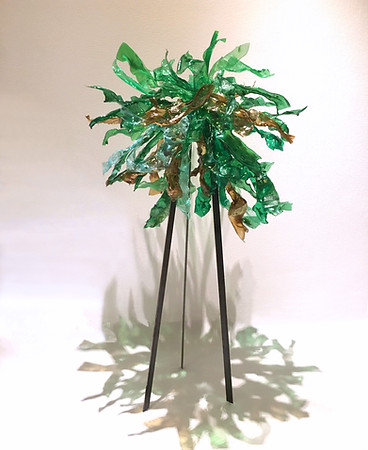Charlotte Payet
Visual Artist | visuelle Künstlerin


Plastikalge
Plastic algae, 2020 / January 2021
Dimension: Nr.1 : 160 cm x 70 cm x 75 cm Nr.2 : 160 cm x 70 cm x 75 cm Nr.3 : 46 cm x 95 cm x 90 cm
pfandfreie PET Flaschen - deposit-free PET bottles
Jedes Jahr gelangen ca. 10 Millionen Tonnen Kunststoff im Ozean, dieser zählt mittlerweile zu den dreckigsten Orten der Welt. Plastiktüten, Plastikflaschen, Strohhalme und Zahnbürsten werden von gigantischen Müllstrudeln angezogen und bilden riesige Inseln oder werden an die Strände gespült. Auch die Lebewesen im Meer leiden unter der „Vermüllung“, denn sie verwechseln die kleinen Plastikteile mit Nahrung und sterben an den giftigen Zusatzstoffen. Diese Lebewesen nimmt der Mensch in seiner Nahrung auf, sodass das Plastik ebenfalls im menschlichen Körper landet und sich der Kreis des Ökosystems schließt.
Verpackungen, wie zum Beispiel Plastikflaschen bestehen meist aus PET. Forschungen besagen, dass gewisse Bakterien dieses PET womöglich abbauen können. Bestimmte Algensorten geben ein Enzym ab, das die Kettenmoleküle des Kunststoffs in seine Bestandteile zersetzt. Dies ist vor allem für den Abbau von Mikroplastik hilfreich, denn der Mensch kann diese winzig kleinen Stücke nicht erfassen.
Die Skulptur besteht aus recyceltem PET und verkörpert auf abstrakte Weise eine überdimensionale Meeresalge.
___________________
Every year, about 10 million tonnes end up in the ocean, which is now one of the dirtiest places on earth. Plastic bags, plastic bottles and straws are attracted by gigantic Garbage Patches and form huge islands or are flushed to the beaches. The creatures in the sea also suffer from the "littering", because they confound the small plastic parts with food and die from the toxic additives. Humans include these creatures in their food, so that the plastic also ends up in the human body and the circle of the ecosystem closes itself.
Packages, such as plastic bottles, are usually made of PET. Researches prove that certain bacteria may be able to decompose PET. Specific types of algae produce an enzyme that breaks down the chain molecules of the plastic into its components. This is especially helpful for degrading microplastics, because humans cannot detect these tiny pieces.
The sculpture is made of recycled PET bottles and embodies an oversized seaweed in an abstract way.

Aeternum, June 2020 - June 2021
2,80 m Säule bestehend aus vier Teilen: 2 Keramikteile und 2 Kunststoffteile aus verformten PETG und Stahl.
Diese Arbeit lehnt sich an die Idee der Unendlichkeit an, die der Mensch mit dem bloßen Auge nicht einfangen kann. Es entstanden zwei abstrakte Keramikformen, die sich spielerisch in die Höhe des Raumes schlängeln und bei denen die Unter- und Oberfläche immer der gleichen Form entspricht. Das flexible Aufeinanderstapeln in jeglicher Reihenfolge ist damit gewährleistet. Erweitert wurden beide Keramiken durch Abformungen in transparentes Kunststoff, dieser Prozess könnte auf ein unendliches wiederholt werden und würde die Säule immer größer werden lassen.
_____
2,80 meter column composed of 4 pieces: 2 ceramic pieces and 2 synthetic plastic pieces made of PETG and steel.
This work leans on the idea of the eternity, that man cannot capture with the naked eye. Two abstract ceramic forms were created, which playfully twist up into the height of the room and in which the lower and upper surfaces always correspond to the same shape. Flexible stacking in any order is thus guaranteed. Both ceramics were extended by moulding them in transparent plastic; this process could be repeated ad infinitum and would make the column grow ever larger.
